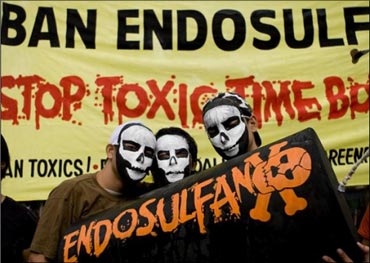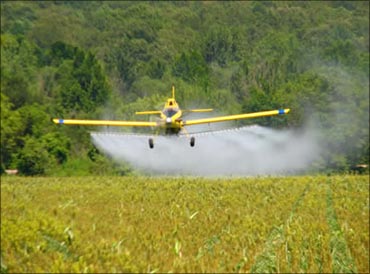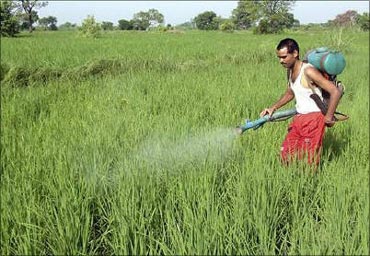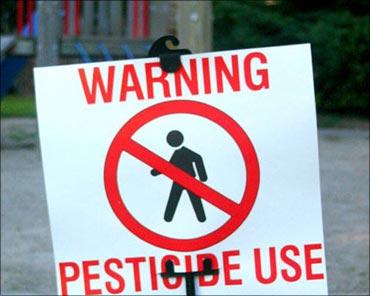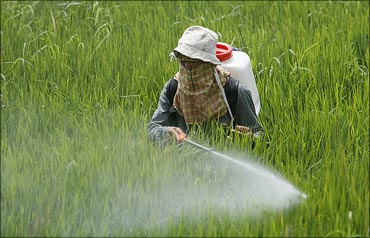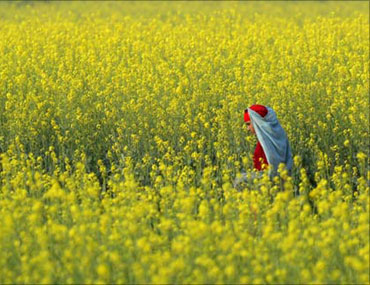 | « Back to article | Print this article |
All you want to know about endosulfan controversy
Amid demands for a total ban on endosulfan at home, India and a few developing nations on Friday managed to secure several exemptions, including a phase-out period of 11 years to implement the ban on production and use of the toxic pesticide at an international conference in Geneva.
"All the exemptions demanded by India and other developing countries, particularly a long phase-out period as well as access to safe and cost-effective alternatives, have been agreed," a senior official of the environment ministry told PTI.
At the concluding session of the Conference of the Parties to the Stockholm Convention on Persistent Organic Pollutants (POPs) in Geneva a final decision will be adopted based on two draft decisions that take on board India's concerns, the official said.
Endosulfan is widely used in cultivation of several agricultural crops.
Click NEXT to read on . . .
All you want to know about endosulfan controversy
What is endosulfan?
Endosulfan is one of the most toxic pesticides available in the market. It is an organic contact insecticide, first registered in Germany in 1954.
It is a colourless solid and a major item of controversy with lobbies for and against its ban raising their voices that can be heard across the globe.
Endosulfan has been banned in over 80 nations due to its 'high toxicity, potential for bioaccumulation, and role as an endocrine disruptor'.
India is the heaviest user and producer of endosulfan. Reports say that it produces over 80 per cent of the endosulfan in the world. Endosulfan has been in use for over 50 years and continues to help protect some 29 crops from about 60 types of pests.
A cheap insecticide, it is used widely by Indian farmers.
Click NEXT to read on . . .
All you want to know about endosulfan controversy
Europe produced endosulfan for most of the last century since it was registered. In India, production of endosulfan began in 1980 and the country has over time become the leading manufacturer of the pesticide. Almost 10,000 workers are directly engaged in this industry, which helps provide the insecticide to over 7.5 crore (75 million) Indian farmers at highly affordable prices.
What scientists say
However, European scientists say that endosulfan is extremely dangerous to human beings and should be banned across the globe.
The Stockholm Convention on Persistent Organic Pollutants, a global regime to protect human health and the environment from dangerous chemicals, has been held to decide on this.
Environmentalists too say that endosulfan is one of the prime agents of pesticide poisoning. Many studies point out that it has been dreadfully toxic to humans, fish and other aquatic life. It causes a plethora of adverse effects, including death, disease, and birth defects, among humans and animals.
The toxicity would result in cancer, allergies and hypersensitivity, damage to the central and peripheral nervous systems, reproductive disorders, and disruption of the immune system.
Click NEXT to read on . . .
All you want to know about endosulfan controversy
The link between endosulfan and human miseries had come to the surface for the first time in Kerala in the 1980s when several cases of ailments and deaths were reported in the Kasargod district of Kerala where a number of villages were severely affected by endosulfan, says DownToEarth magazine.
Almost a decade back, the National Institute of Occupational Health, upon the directive of Indian Council of Medical Research, had presented a report to the Government of India linking the use of endosulfan to the prevalence of health disorders.
However, DownToEarth charges that 'the NIOH report has been sabotaged by the pesticide lobby which has been trying to undercut the negative findings on the use of endosulfan.'
The NIOH noted that there was a significantly higher prevalence of learning disabilities, low IQ and scholastic backwardness among children, besides serious neurological problems and congenital and reproductive abnormalities among people in the region.
The NIOH report has been confirmed by the team of doctors of the Department of Community Medicine, Medical College, Calicut who conducted an epidemiological investigation since October 2010 upon the directive of the Government of Kerala.
Click NEXT to read on . . .
All you want to know about endosulfan controversy
Farmers not happy with ban
"Farmers are intelligent and they know what is good for them. So let the farmers decide whether Endosulfan they have used for many decades is good for them or not. Give them the choice," says Consortium of Indian Farmers Associations secretary general P Chengal Reddy
Highly concerned with the meeting of the Stockholm Convention currently taking place at Geneva to discuss the fate of widely used pesticide Endosulfan, he asked who are they to decide what is good for Indian farmers.
"Farmers are using it for over 50 years and have found it very effective and affordable. So why they should be asked to stop its use and go for any other alternatives," he pointed out. No body raised this issue of banning use of Endosulfan, so long as European multi-nations were manufacturing it and were minting money, Reddy stated.
Reddy further pointed out that farmers all over the country are using endosulfan to protect various fruits and vegetables from pest attack along with different agricultural crops such as tea, coffee and cotton.
"Farmers in Andhra Pradesh, Tamil Nadu, Maharashtra, Gujarat, West Bengal and other states are using Endosulfan for many decades and neither the farmers, their workers or the consumers of these produces in the country have found it adversely affecting their health," he emphasised.
Click NEXT to read on . . .
All you want to know about endosulfan controversy
Tough negotiations in Geneva
After intense negotiations over the last five days as to how the Parties to the Stockholm Convention on Persistent Organic Pollutants must deal with endosulfans, India and other developing countries such as Indonesia have agreed to join the 'consensus' because the two draft decisions fully address all their concerns, said another developing country official.
Under draft A, the parties to the Stockholm convention on POPs have agreed to include endosulfan in Annex A of banned organic chemicals.
Once the parties adopt the decision to include endosulfan in the Annex A, they will have a period eleven years- in two instalments- to phase out the use and ban of endosulfan which is currently used in the cultivation of about 15-20 crops such as cotton, coffee and maize.
The second draft deals with a work programme in which countries heavily dependent on the production and use of endosulfan until now will be provided 'safe and cost-effective alternatives that would include technical assistance as well as access to latest scientific know-how', the official said.
These two draft decisions are expected to be merged during the final session in the evening on Thursday.
Click NEXT to read on . . .
All you want to know about endosulfan controversy
Even as Kerala Chief Minister V S Achutahananandan raised the political heat by calling for the immediate ban of endosulfan, the central government adopted a cautious position that all aspects relating to this deadly pesticide must be properly examined and decided through consensus.
In addition to endosulfan, there will be eight other new other PoPs that will be included in the Annex A due to several harmful effects on the environment, and bioaccumulation in organisms (increases in concentration up the food chain).
India adopted a tough negotiating position on endosulfan in the face of intense domestic political agitations as well as attempts by European countries to steamroll a decision with few exemptions.
Several developing countries also called for "exceptions" and unimpeded access to alternatives in the event endosulfan is included in Annex A list of chemicals by the Persistent Organic Pollutants Review Committee (POPRC).
Click NEXT to read on . . .
All you want to know about endosulfan controversy
Initially, India raise opposition to the inclusion of the recommendation to include endosulfan in Annex A by the Persistent Organic Pollutants Review Committee (POPRC).
Chemicals listed in Annex A are banned for production and use due to the threat they pose to living beings, particularly environment.
In its review meeting last year, POPRC included endosulfan in Annex A.
India said a decision on endosulfan must be based on "consensus" as per the practice in all multilateral meetings.
Given the differences between the industrialised countries on one side who want the ban of production and use of endosulfan, and developing countries who are demanding technical and financial assistance as well as transfer of technology during the phase-out period, the COP5 has constituted a contact group to examine all the issues and suggest its recommendations.

